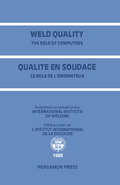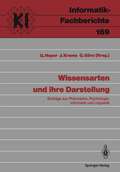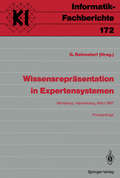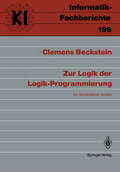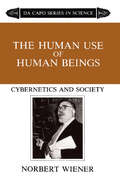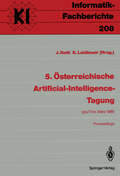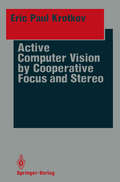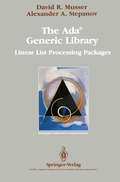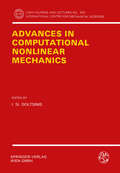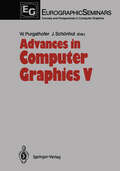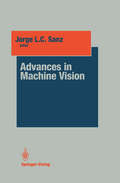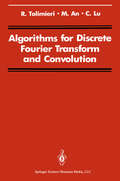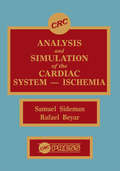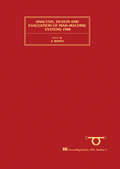- Table View
- List View
VLSI Specification, Verification and Synthesis (The Springer International Series in Engineering and Computer Science #35)
by Graham Birtwistle P. A. SubrahmanyamVLSI Specification, Verification and Synthesis Proceedings of a workshop held in Calgary from 12-16 January 1987. The collection of papers in this book represents some of the discussions and presentations at a workshop on hardware verification held in Calgary, January 12-16 1987. The thrust of the workshop was to give the floor to a few leading researchers involved in the use of formal approaches to VLSI design, and provide them ample time to develop not only their latest ideas but also the evolution of these ideas. In contrast to simulation, where the objective is to assist in detecting errors in system behavior in the case of some selected inputs, the intent of hardware verification is to formally prove that a chip design meets a specification of its intended behavior (for all acceptable inputs). There are several important applications where formal verification of designs may be argued to be cost-effective. Examples include hardware components used in "safety critical" applications such as flight control, industrial plants, and medical life-support systems (such as pacemakers). The problems are of such magnitude in certain defense applications that the UK Ministry of Defense feels it cannot rely on commercial chips and has embarked on a program of producing formally verified chips to its own specification. Hospital, civil aviation, and transport boards in the UK will also use these chips. A second application domain for verification is afforded by industry where specific chips may be used in high volume or be remotely placed.
Weld Quality: Proceedings of the International Conference on Improved Weldment Control with Special Reference to Computer Technology Held in Vienna, Austria, 4–5 July 1988 under the Auspices of the International Institute of Welding
by Sam StuartWeld Quality: The Role of Computers documents the proceedings of the International Conference on Improved Weldment Control with Special Reference to Computer Technology, held in Vienna, Austria, 4-5 July 1988, under the auspices of the International Institute of Welding. The topics of the four sessions are: (I) Design, Calculation and Prediction Models For Metallurgical Processes/Conception; (II) Inspection and In-Service Monitoring; (III) Fabrication, Quality Assurance; and (IV) Expert Systems, Data Banks and Future Possibilities. Session I includes papers on the use of computer technology to establish the quality of the welded joints; computer-aided design system for design of fillet welds with optimum shape; and the use of numerical simulation software for predetermination and optimization of the mechanical resistance of brazed joints. The papers in Session II cover topics such as acoustic emission testing; eddy current inspection system for weld testing; and holographic imaging of weld cracks. Session III includes papers on a computer controlled friction welding system and a CAQ-system for welding workshops. The presentations in Session IV include an approach for writing conventional software and expert systems for welding engineers and an expert system for robotic welding.
Wissensarten und ihre Darstellung: Beiträge aus Philosophie, Psychologie, Informatik und Linguistik (Informatik-Fachberichte #169)
by Gerhard Heyer Josef Krems Günther GörzDas Buch enthält Beiträge zu einer interdisziplinären Tagung zur Cognitive Science. Im Vordergrund steht die Repräsentationsproblematik bei der Anwendung von Methoden der Informationsverarbeitung auf die kognitive Modellierung und umgekehrt. Das Prinzip informationsverarbeitender Systeme wird vom Standpunkt der Philosophie, Linguistik, Psychologie und Informatik beleuchtet und mit den jeweils unterschiedlichen Methoden der genannten Wissenschaften vorgestellt. Die Beiträge sind nach der Tagung substantiell überarbeitet worden, wobei sich die Autoren um eine gemeinsame Terminologie und das Verständnis für die fachspezifischen Probleme der jeweils anderen Wissenschaften bemüht haben. Das Buch gliedert sich in vier thematische Bereiche, die von den Herausgebern ausführlich eingeleitet werden: Philosophische Aspekte der Repräsentationsproblematik, Repräsentation sprachlichen Wissens, psychologische Aspekte der Repräsentationsproblematik, KI-Aspekte der Repräsentationsproblematik. Das Buch dokumentiert somit den aktuellen Forschungsstand der kognitionswissenschaftlichen Forschung in der BRD. Gegenüber fachspezifischen Veröffentlichungen zeichnet es sich durch seine breite Perspektive aus, durch die es an Lesbarkeit für alle an der Cognitive Science Interessierten gewinnt und einen Beitrag zur gegenseitigen Horizonterweiterung leistet.
Wissensrepräsentation in Expertensystemen: Workshop, Herrenberg, 16.18. März 1987 Proceedings (Informatik-Fachberichte #172)
Das Buch enthält die Beiträge des Workshops "Wissensrepräsentation in Expertensystemen", der vom 16. bis 18.3.1987 von der IBM Deutschland GmbH in Herrenberg durchgeführt wurde. Wissensrepräsentation ist für viele Anwendungen der Künstlichen Intelligenz von zentraler Bedeutung. Bei der Umsetzung von Ergebnissen der Forschung in Anwendungen wird die Wissensrepräsentation wegen ihrer Verankerung in so verschiedenen Gebieten wie Logik, Linguistik und Psychologie unübersichtlich. Es gibt keine einheitliche Systematisierung. Hinzu kommt, daß die Probleme der Wissensrepräsentation erst an größeren Anwendungen in ihrer vollen Tragweite erkennbar werden. In dem Workshop wurde daher versucht, das Thema interdisziplinär und systematisch zu behandeln. Dabei ging es weniger um die Darstellung von Projekten, bei denen die Wissensrepräsentation meistens nur peripher und unter spezifischen Projektaspekten diskutiert wird, sondern um eine gezielte Thematisierung der zentralen Fragestellungen in aufeinander abgestimmten Abschnitten: Orientierung und Grundlagen, Sprachen und Methoden der Wissensrepräsentation, Spezifische Teilprobleme (Raum- und Zeitaspekte), Wissenserwerb und Wissensverarbeitung. Das Buch stellt in konzentrierter Form Beiträge von herausragenden Forschern auf diesem Gebiet zusammen.
Zur Logik der Logik-Programmierung: Ein konstruktiver Ansatz (Informatik-Fachberichte #199)
by Clemens BecksteinThe Human Use Of Human Beings: Cybernetics And Society
by Norbert WienerOnly a few books stand as landmarks in social and scientific upheaval. Norbert Wiener's classic is one in that small company. Founder of the science of cybernetics-the study of the relationship between computers and the human nervous system-Wiener was widely misunderstood as one who advocated the automation of human life. As this book reveals, his vision was much more complex and interesting. He hoped that machines would release people from relentless and repetitive drudgery in order to achieve more creative pursuits. At the same time he realized the danger of dehumanizing and displacement. His book examines the implications of cybernetics for education, law, language, science, technology, as he anticipates the enormous impact-in effect, a third industrial revolution-that the computer has had on our lives.
5. Österreichische Artificial-Intelligence-Tagung: Igls/Tirol, 28.-31. März 1989 Proceedings (Informatik-Fachberichte #208)
by Johannes Retti Karl LeidlmairActive Computer Vision by Cooperative Focus and Stereo (Springer Series in Perception Engineering)
by Eric P. KrotkovThis book addresses an area of perception engineering which deals with constructive processes. A model of the environment is analyzed using the information acquired from mUltiple viewpoints of multiple disparate sensors at multiple time instants. Although the role of successive model building and active exploration of the environment, as is discussed in this book, is of great importance, only a few researchers of machine perception have thus far addressed the problem in these directions. Krotkov's book, which is a modification and continuation of his highly successful dissertation, focuses on active exploratory sensing in the context of spatial layout perception. He uses stereo and focus to obtain distance By information, and to eventually develop cooperative combining techniques. means of a stereo system with verging cameras, it is demonstrated that the distance measurements can be significantly improved by combining two sources. In addition, the problem of merging information from the multiple views is discussed in detail. As the field of perception engineering seems to be of growing scientific and applied importance, both practitioners and researchers in machine perception will find this book a valuable addition to their libraries. RameshJain Series Editor Acknowledgements I would like to thank Professor Ruzena Bajcsy for her constant encouragement and guidance during the five years of research leading to the dissertation upon which this book is based. Without her help in all matters, this work would never have been possible.
The Ada® Generic Library: Linear List Processing Packages (Springer Compass International)
by David R. Musser Alexander A. StepanovThe Ada Generic Library provides an extensive well-documented library of generic packages whose use can substantially increase software productivity and reliability. The construction of the library follows a new approach whose principles include the following: - Extensive use of generic algorithms, such as generic sort and merge. - Building up functionality in layers. - Obtaining high efficiency in spite of the layering through the use of Ada's inline compiler directive. This volume contains eight Ada packages, with over 170 subprograms for various linear data structures based on linked lists. Professional Ada programmers will find The Ada Generic Library an invaluable tool in building application programs or in further construction of generic libraries. For these users the source code can be obtained on diskettes. The volume will also be useful to those interested in programming methodology, software reusability, and software engineering.
Advanced Information Technologies for Industrial Material Flow Systems (NATO ASI Subseries F: #53)
by Shimon Y. Nof Colin L. MoodieThis book contains the results of an Advanced Research Workshop that took place in Grenoble, France, in June 1988. The objective of this NATO ARW on Advanced Information Technologies for Industrial Material Flow Systems (MFS) was to bring together eminent research professionals from academia, industry and government who specialize in the study and application of information technology for material flow contro!' The current world status was reviewed and an agenda for needed research was discussed and established. The workshop focused on the following subjects: The nature of information within the material flow domain. Status of contemporary databases for engineering and material flow. Distributed databases and information integration. Artificial intelligence techniques and models for material flow problem solving. Digital communications for material flow systems. Robotics, intelligent systems, and material flow contro!' Material handling and storage systems information and contro!' Implementation, organization, and economic research-issues as related to the above. Material flow control is as important as manufacturing and other process control in the computer integrated environment. Important developments have been occurring internationally in information technology, robotics, artificial intelligence and their application in material flow/material handling systems. In a traditional sense, material flow in manufacturing (and other industrial operations) consists of the independent movement of work-in-process between processing entities in order to fulfill the requirements of the appropriate production and process plans. Generally, information, in this environment, has been communicated from processors to movers.
Advanced Programming Methodologies
by Gianna Cioni Andrzej SalwickiAdvanced Programming Methodologies consists of lecture demos and practical experiments from the Summer School on Advanced Programming Methodologies which took place in Rome, Italy, on September 17-24, 1987. The school focused on tools of advanced programming as well as theoretical foundations for software engineering. Problems connected with implementation and application of high-level programming languages are highlighted.Comprised of 11 chapters, this volume first looks at two software development projects at the Institute of Informatics of the University of Warsaw in Poland, with emphasis on the methodologies used in programming and implementation. The reader is then introduced to flexible specification environments; object-oriented programming; and Paragon's type hierarchies for data abstraction. Subsequent chapters focus on the inheritance rule in object-oriented programming; a functional programming approach to modularity in large software systems; database management systems; and relational algebra and fixpoint computation for logic programming implementation. The book also examines modules in high-level programming languages before concluding with a chapter devoted to storage management.This book is intended for computer programmers, undergraduate students taking various courses in programming, and advanced students of computer science.
Advanced Programming with Microsoft QuickC
by Keith WeiskampAdvanced Programming with Microsoft QuickC provides the necessary programming tools for programmers who are interested in learning new skills in developing some useful tools and PC applications using the QuickC programming language.The book emphasizes practical and useful programming examples. It is organized into five sections. The first section introduces the proposed ANSI standard features, tips and techniques about C programming style, working with the C preprocessor, and tips for using pointers and managing memory allocation tasks. Section 2 presents data structures, discussing techniques for constructing useful and reliable data structures from linked lists to binary trees. The third section covers the many tools that QuickC provides for accessing files and other I/O devices. Section 4 explains the techniques for interacting with DOS andthe special features of QuickC. The final chapter presents the tools and techniques for developing QuickC-like user interfaces.Computer programmers will find the text very useful.
Advances in Computational Nonlinear Mechanics (CISM International Centre for Mechanical Sciences #300)
by I. S. DoltsinisAdvanced computational methods in nonlinear mechanics of solids and fluids are dealt with in this volume. Contributions consider large deformations of structures and solids, problems in nonlinear dynamics, aspects of earthquake analysis, coupled problems, convection-dominated phenomena, and compressible and incompressible viscous flows. Selected applications indicate the relevance of the analysis to the demands of industry and science. The contributors are from research institutions well-known for their work in this field.
Advances in Computer Graphics V (Focus on Computer Graphics)
by Werner Purgathofer Jürgen SchönhutThis book collects together several of the tutorials held at EUROGRAPHICS'89 in Hamburg. The conference was held under the motto "Integration, Visualisation, Interaction" and the tutorials reflect the conference theme. The Springer series EurographicSeminars with the volumes "Advances in Computer Graphics" regularly provides a professional update on current mainstream topics in the field. These publications give readers the opportunity to inform themselves thoroughly on the topics covered. The success of the series is mainly based on the expertise of the contributing authors, who are recognized professionals in their field. Starting out with one of the conference's main topics, the chapter "Visualization of Scientific Data" gives an overview of methods for displaying scientific results in an easily surveyable and comprehensible form. It presents algorithms and methods utilized to achieve visualization results in a form adequate for humans. User interfaces for such systems are also explored, and practical conclusions are drawn. The chapter "Color in Computer Graphics" describes the problems of manipulating and matching color in the real world. After some fundamental statements about color models and their relationships, the main emphasis is placed on the problem of objective color specification for computer graphics systems. It is very hard to match colors between devices such as scanners, printers and displays. Some suggestions on the effective use of color for graphics are also made.
Advances in Machine Vision (Springer Series in Perception Engineering)
by Jorge L. C. SanzMachine Vision technology is becoming an indispensible part of the manufacturing industry. Biomedical and scientific applications of machine vision and imaging are becoming more and more sophisticated, and new applications continue to emerge. This book gives an overview of ongoing research in machine vision and presents the key issues of scientific and practical interest. A selected board of experts from the US, Japan and Europe provides an insight into some of the latest work done on machine vision systems and appliccations.
Algebraic Specifications in Software Engineering: An Introduction
by Ivo Van Horebeek Johan Lewi"I prefer to view formal methods as tools. the use of which might be helpful." E. W. Dijkstra Algebraic specifications are about to be accepted by industry. Many projects in which algebraic specifications have been used as a design tool have been carried out. What prevents algebraic specifications from breaking through is the absence of introductory descriptions and tools supporting the construction of algebraic specifications. On the one hand. interest from industry will stimulate people to make introductions and tools. whereas on the other hand the existence of introductions and tools will stimulate industry to use algebraic specifications. This book should be seen as a contribution towards creating this virtuous circle. The book will be of interest to software designers and programmers. It can also be used as material for an introductory course on algebraic specifications and software engineering at undergraduate or graduate level. Nowadays. there is general agreement that in large software projects appropriate specifications are a must in order to obtain quality software. Informal specifications alone are certainly not appropriate because they are incomplete. inconsistent. inaccurate and ambiguous and they rapidly become bulky and therefore useless. The only way to overcome this problem is to use formal specifications. An important remark here is that a specification formalism (language) alone is not sufficient. What is also needed is a design method to write specifications in that formalism.
Algorithm Synthesis: A Comparative Study
by David M. Steier A. Penny AndersonIn early 1986, one of us (D.M.S.) was constructing an artificial intelligence system to design algorithms, and the other (A.P.A.) was getting started in program transformations research. We shared an office, and exchanged a few papers on the systematic development of algorithms from specifications. Gradually we realized that we were trying to solve some of the same problems. And so, despite radical differences between ourselves in research approaches, we set out together to see what we could learn from these papers. That's how this book started: a couple of graduate students trying to cope with The Literature. At first, there was just a list of papers. One of us (D.M.S.) tried to cast the papers in a uniform framework by describing the problem spaces searched, an approach used in artificial intelligence for understanding many tasks. The generalized problem space descriptions, though useful, seemed to abstract too much, so we decided to compare papers by different authors dealing with the same algorithm. These comparisons proved crucial: for then we began to see similar key design choices for each algorithm.
Algorithms and Model Formulations in Mathematical Programming (NATO ASI Subseries F: #51)
by Stein W. WallaceThe NATO Advanced Research Workshop (ARW) "Algorithms and Model Formulations in Mathematical Programming" was held at Chr. Michelsen Institute in Bergen, Norway, from June 15 to June 19, 1987. The ARW was organized on behalf of the Committee on Algorithms (COAL) of the Mathematical Programming Society (MPS). Co-directors were Jan Telgen (Van Dien+Co Organisatie, Utrecht, The Netherlands) and Roger J-B Wets (The University of California at Davis, USA). 43 participants from 11 countries attended the ARW. The workshop was organized such that each day started with a - minute keynote presentation, followed by a 45-minute plenary discussion. The first part of this book contains the contributions of the five keynote speakers. The plenary discussions were taped, and the transcripts given to the keynote speakers. They have treated the transcripts differently, some by working the discussions into their papers, others by adding a section which sums up the discussions. The plenary discussions were very interesting and stimulating due to active participation of the audience. The five keynote speakers were asked to view the topic of the workshop, the interaction between algorithms and model formulations, from different perspectives. On the first day of the workshop Professor Alexander H.G. Rinnooy Kan (Erasmus University, Rotterdam, The Netherlands) put the theme into a larger context by his talk "Mathematical programming as an intellectual activity". This is an article of importance to any mathematical programmer who is interested in his field's history and present state.
Algorithms and Order (Nato Science Series C: #255)
by Ivan RivalThis volume contains the texts of the principal survey papers presented at ALGORITHMS -and ORDER, held· at Ottawa, Canada from June 1 to June 12, 1987. The conference was supported by grants from the N.A.T.O. Advanced Study Institute programme, the University of Ottawa, and the Natural Sciences and Engineering Research Council of Canada. We are grateful for this considerable support. Over fifty years ago, the Symposium on Lattice Theory, in Charlottesville, U.S.A., proclaimed the vitality of ordered sets. Only twenty years later the Symposium on Partially Ordered Sets and Lattice Theory, held at Monterey, U.S.A., had solved many of the problems that had been originally posed. In 1981, the Symposium on Ordered Sets held at Banff, Canada, continued this tradition. It was marked by a landmark volume containing twenty-three articles on almost all current topics in the theory of ordered sets and its applications. Three years after, Graphs and Orders, also held at Banff, Canada, aimed to document the role of graphs in the theory of ordered sets and its applications. Because of its special place in the landscape of the mathematical sciences order is especially sensitive to new trends and developments. Today, the most important current in the theory and application of order springs from theoretical computer seience. Two themes of computer science lead the way. The first is data structure. Order is common to data structures.
Algorithms for Discrete Fourier Transform and Convolution (Signal Processing and Digital Filtering)
by Richard Tolimieri Myoung An Chao LuThis easily accessible book provides a broad view of the latest developments in the field of fast digital signal processing algorithms. It bridges the gap between DSP algorithms and their implementation on a variety of serial and super computers.
Analog VLSI Implementation of Neural Systems (The Springer International Series in Engineering and Computer Science #80)
by Carver Mead Mohammed IsmailThis volume contains the proceedings of a workshop on Analog Integrated Neural Systems held May 8, 1989, in connection with the International Symposium on Circuits and Systems. The presentations were chosen to encompass the entire range of topics currently under study in this exciting new discipline. Stringent acceptance requirements were placed on contributions: (1) each description was required to include detailed characterization of a working chip, and (2) each design was not to have been published previously. In several cases, the status of the project was not known until a few weeks before the meeting date. As a result, some of the most recent innovative work in the field was presented. Because this discipline is evolving rapidly, each project is very much a work in progress. Authors were asked to devote considerable attention to the shortcomings of their designs, as well as to the notable successes they achieved. In this way, other workers can now avoid stumbling into the same traps, and evolution can proceed more rapidly (and less painfully). The chapters in this volume are presented in the same order as the corresponding presentations at the workshop. The first two chapters are concerned with fmding solutions to complex optimization problems under a predefmed set of constraints. The first chapter reports what is, to the best of our knowledge, the first neural-chip design. In each case, the physics of the underlying electronic medium is used to represent a cost function in a natural way, using only nearest-neighbor connectivity.
Analogical Modeling of Language
by R. Skousen1. Structuralist Versus Analogical Descriptions ONE important purpose of this book is to compare two completely dif ferent approaches to describing language. The first of these approaches, commonly called stnlctllralist, is the traditional method for describing behavior. Its methods are found in many diverse fields - from biological taxonomy to literary criticism. A structuralist description can be broadly characterized as a system of classification. The fundamental question that a structuralist description attempts to answer is how a general contextual space should be partitioned. For each context in the partition, a rule is defined. The rule either specifies the behavior of that context or (as in a taxonomy) assigns a name to that context. Structuralists have implicitly assumed that descriptions of behavior should not only be correct, but should also minimize the number of rules and permit only the simplest possible contextual specifications. It turns out that these intuitive notions can actually be derived from more fundamental statements about the uncertainty of rule systems. Traditionally, linguistic analyses have been based on the idea that a language is a system of rules. Saussure, of course, is well known as an early proponent of linguistic structuralism, as exemplified by his characterization of language as "a self-contained whole and principle of classification" (Saussure 1966:9). Yet linguistic structuralism did not originate with Saussure - nor did it end with "American structuralism".
Analysis and Simulation of the Cardiac System Ischemia
by Rafael Beyar Samuel SidemanOver thiry-five experts contribute to this publication about the various interactions and interrelationships of the parameters which affect the normal and ischemic heart. Mechanical aspects related to the global and regional function of the heart are discussed. Coronary perfusion of the ischemic heart is considered, with emphasis on the effects of reperfusion. Electrical activation, formation of arrhythmias, and the effects of ischemia or ionic transport in the myocardium are presented. Metabolic aspects of the ischemic heart, including calcium transport, are also explained.
Analysis and Simulation of the Cardiac System Ischemia
by Rafael Beyar Samuel SidemanOver thiry-five experts contribute to this publication about the various interactions and interrelationships of the parameters which affect the normal and ischemic heart. Mechanical aspects related to the global and regional function of the heart are discussed. Coronary perfusion of the ischemic heart is considered, with emphasis on the effects of reperfusion. Electrical activation, formation of arrhythmias, and the effects of ischemia or ionic transport in the myocardium are presented. Metabolic aspects of the ischemic heart, including calcium transport, are also explained.
Analysis, Design and Evaluation of Man-Machine Systems 1988: Selected Papers from the Third IFAC/IFIP/IEA/IFORS Conference, Oulu, Finland, 14-16 June 1988 (IFAC Symposia Series)
by J. RantaThis volume provides a state-of-the-art review of the development and future use of man-machine systems in all aspects of business and industry. The papers cover such topics as human-computer interaction, system design, and the impact of automation in general, and also by the use of case studies describe a wide range of applications in such areas as office automation, transportation, power plants, machinery and manufacturing processes and defence systems. Contains 73 papers.

